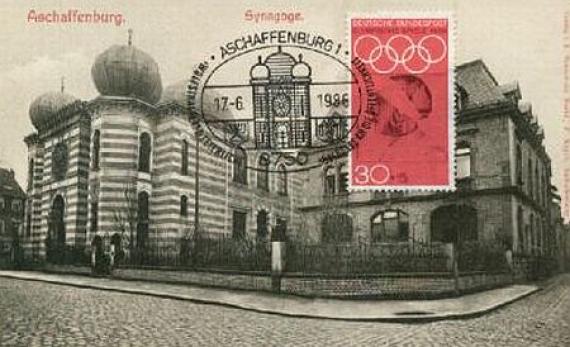Wolfsthalplatz
63739 Aschaffenburg
Germany
The medieval Jewish residential area was located in the city center near the market district in the area of Große Metzgergasse (today Dalbergstraße)/Stiftsplatz. A synagogue was first mentioned in 1344. It stood in the Dalbergstraße/Rathausgasse corner before and after the persecution in the plague period. It is mentioned as "Judenschule" (1363, 1383, 1385, 1397, 1437) or as "synagoga Judeorum" (1402). Until the middle of the 15th century it was used for the services of the Jewish community. For unknown reasons, it fell into disrepair and was completely destroyed in 1459.
After Jewish families in the town moved in again in the course of the 2nd half of the 17th century, a new synagogue was established in 1696, which was expanded and renovated several times in the following two centuries.
In 1838, new synagogue regulations were adopted. At that time, a comprehensive repair and refurnishing of the synagogue was already on the agenda, which was carried out in 1839/40.
During the November pogrom in 1938, about 30 SA people entered the synagogue and set fire to it. Rituals, carpets, 15 Torah scrolls, a precious Torah shrine curtain, and the congregational archives (including files and documents on the history of the congregation and the district rabbinate going back to 1760) went up in flames, and the building burned out. The extensive library was confiscated. In the Jewish community center, which remained intact, it was possible to hold services after Pogrom Night until the beginning of the deportations.
After 1945, the property of the former synagogue came into the possession of the city of Aschaffenburg. The synagogue square was renamed Wolfsthalplatz (named after the Jewish banker and benefactor Otto Wolfsthal (1872-1942)), who along with six co-religionists had put an end to his life before the deportation in September 1942. The square was redesigned as a memorial in 1984 according to plans by the Darmstadt architect Philipp Economou; a sycamore grove was planted on the site of the synagogue. In 1984, the Documentation Center of Aschaffenburg Jews was established in the former Jewish community center (inaugurated on July 27, 1984). In the exhibition rooms, the history of the Jewish community of Aschaffenburg, which spans more than 700 years, from its beginnings to the end of the Nazi era, is presented on 26 display boards. In addition, a few preserved objects of worship, supplemented by film presentations, convey an impression of religious life. Through a built-in Torah shrine, there is the possibility to hold a Jewish service.
